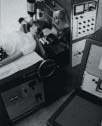 A Brief History
A Brief History
DOE's Molecular Nuclear Medicine Research
For over 70 years, the Department's Office of Science and its predecessors have supported basic physical science research for meeting the nation's defense and security needs. The Office of Science Office of Biological and Environmental Research program has served as the Department's primary research arm for addressing health and environmental consequences and the potential public payoffs of atomic energy explorations and use by translating the fundamental energy science to basic technology innovations and development for medical applications. Along the way, the program has leveraged the Department's unique capabilities in radiation chemistry, physics, engineering, computation, and biology, together with capabilities in and responsibilities for radiation detection and nuclear materials to support basic, high-risk research that today provides the upstream basis to use radiation and other energy technologies in medicine.
The mission of the subprogram is to deliver relevant scientific knowledge that will lead to innovative diagnostic and treatment technologies for human health. The basic research technologies growing out of this program offer applications for noninvasive detection, diagnosis, and early intervention of natural causes of disease, as well as of human health risks associated with exposure to chemical, biological, and nuclear material.
The modern era of nuclear medicine is an outgrowth of the original charge of the Atomic Energy Commission (AEC) "to exploit nuclear energy to promote human health." Today the program, through radiopharmaceutical and molecular nuclear medicine research, seeks to develop new applications of radiotracers and in vivo radionuclide detection in diagnosis and treatment by integrating the latest concepts and developments in chemistry; pharmacology; genomic sciences and transgenic animal models; structural, computational and molecular biology; and instrumentation.
The program supports directed nuclear medicine research through radiopharmaceutical development and molecular nuclear medicine activities to study uses of radioisotopes for noninvasive diagnosis and targeted, internal molecular radiotherapy. Molecules directing or affected by homeostatic controls always interact and, thus, are targets for specific molecular substrates. The substrate molecules can be tailored to fulfill a specific need and labeled with appropriate radioisotopes to become measurable in real time in the body on their way to and in interaction with their targets, allowing the analysis of molecular function in homeostatic control in health and disease. The function of radiopharmaceuticals at various sites in the body is imaged by nuclear medical instruments such as gamma cameras and positron emission tomographs (PET). This type of imaging refines diagnostic differentiation at molecular and metabolic levels between health and disease and among various diseases, often leading to more effective therapy.
Basic research in molecular biology has provided new insights into the molecular basis of disease and molecular targets of human diseases. Current radiopharmaceutical and molecular nuclear medicine programs encourage development of new generations of radiolabeled molecules and technologies for molecular delivery of radioisotopes to disease-target sites with a high degree of precision, recognition, and target selectivity.
In addition, nuclear medicine, with the availability of miniaturized PET technology for small-animal imaging, can facilitate mapping of the biochemistry of the metabolic organ function, visualizing the molecular biology of cell function and zooming in on gene function for delineating differences in the molecular biology of normal health from disease in animals and humans.
With the advent of the genome project and the development of transgenic mice, there has been a rapid proliferation of small-animal models of human diseases and improvement in instrumentation technologies for in vivo optical and radionuclide imaging. These technological advancements have offered a paradigm shift in the current level of nuclear medicine research challenges and opportunities. Radiopharmaceutical and molecular nuclear medicine techniques are expected to permit analysis of the molecular elements as markers of genetic manipulations, biological transformations, and disease progression and will provide insights to molecular pathways of disease and gene function.
Timeline (1929–1998)
Publications
- A Vital Legacy [PDF] (1997) — A 50-year progress report on the revolutionary program that gave rise to the Human Genome Project.
- Converting Energy to Medical Progress [PDF] (April 2001) — An introduction to the unique nuclear medicine research funded by the Medical Sciences Division, Biological and Environmental Research (BER), Office of Science, U.S. Department of Energy.
